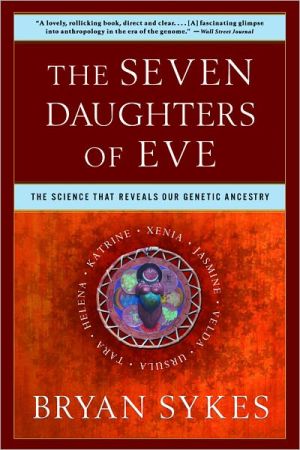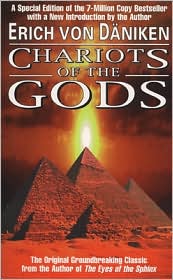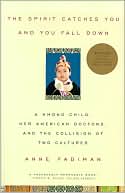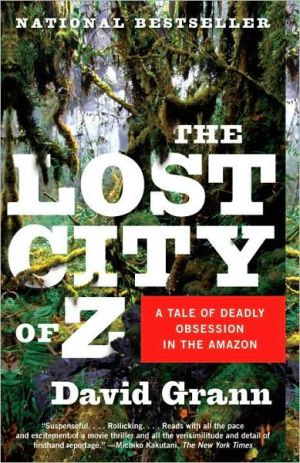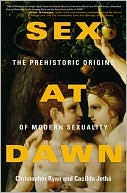Seven Daughters of Eve: The Science That Reveals Our Genetic Ancestry
The national bestseller that reveals how we are descended from seven prehistoric women.\ One of the most dramatic stories of genetic discovery since James Watson's The Double Helix, The Seven Daughters of Eve reveals the remarkable story behind a groundbreaking scientific discovery. After being summoned in 1997 to an archaeological site to examine the remains of a five-thousand-year-old man, Bryan Sykes ultimately was able to prove not only that the man was a European but also that he has...
Search in google:
The Seven Daughters of Eve is a thrilling work of science that reveals how biological research can enrich our tangled lives. It is a book that chronicles many of the most exciting developments in genetics over the past decade by a man who is not only a brilliant scientist but also a gifted and thoroughly engaging writer. It ultimately demonstrates how much more we still have to discover about the absorbing story of human evolution. Salon.com Sykes has become a superstar in the red-hot field of genetics.
\ From Barnes & NobleThe Barnes & Noble Review\ Bryan Sykes, a professor of genetics at the Institute of Molecular Medicine at Oxford University, has made a startling discovery -- Europeans (barring recent immigrants, of course) are all descended from seven women. His research is based on mitochondrial DNA, similar to the research that announced an African "mitochondrial Eve" as the mother of all modern humans. \ Mitochondrial DNA is separate from the DNA we commonly think of and that we inherit from both mother and father. Its purpose is simply to allow cells to function more efficiently, and it is inherited only through the mother's egg. Sykes has been at the forefront of using mitochondrial DNA to solve puzzles about humanity's past. For example, one of his first studies proved that Polynesians have their origin in Asia, not the Americas -- a much more difficult sea voyage (remember the Kon Tiki?). By analyzing the mitochondrial DNA of scores of Europeans, Sykes found that they fell into seven groups (because this DNA does not combine with any other, many people can have exactly the same or very similar mitochondrial DNA). Sykes was even more astounded when he realized that dating the mutations in the DNA revealed that more than 80 percent of current Europeans are descended from the small bands of hunter-gathers who originally came to Europe during the Ice Age -- not from the more "civilized" farmers who came into Europe much later, as was previously thought.\ In order to give a sense of the seven ancestral women as real, flesh-and-blood people, Sykes gave them names: Ursula, Xenia, Helena, Velda, Tara, Katrine, and Jasmine. The book contains charming chapters devoted to each in turn, speculating on the life they may have led. This fascinating and illuminating book will intrigue anyone interested in what science can tell us about our human heritage. (Laura Wood)\ \ \ \ \ \ New York Times Book Review“Sykes recounts his tale of discovery with the drama it warrants...gripping.”\ \ \ Salon.com“Sykes has become a superstar in the red-hot field of genetics.”\ \ \ \ \ New York Times Book ReviewSykes recounts his tale of discovery with the drama it warrants...gripping.\ \ \ \ \ Salon.comSykes has become a superstar in the red-hot field of genetics.\ \ \ \ \ KLIATTBryan Sykes, an Oxford University geneticist, discovered that virtually all of the 560 million modern Europeans descended from seven individual women who lived tens of thousands of years ago. He named them Ursula, Xenia, Helena, Velda, Tara, Katrine, and Jasmine. His research began in 1991 with the discovery in the Italian Alps of a body frozen in the ice. Sykes and his team found that the DNA extracted from the 5000-year-old remains was identical with that of a woman living now in Dorset, England. They also found that DNA could be extracted from ancient bones found in England. Mitochondrial DNA, which is always maternally inherited, led Sykes and his researchers to discover where Polynesians came from (coastal China or Taiwan), what happened to Tsar Nicholas II and his family (most of their remains were found in a shallow grave in 1991), and where all of the humans on earth came from originally. About 11 percent of modern Europeans are direct maternal descendents of Ursula, particularly those living in western Britain and Scandinavia. Twenty-five thousand years ago Xenia and her descendents lived in a chilly Kazakhstan. Today about six per cent can call her mother. Her band populated central Asia and Siberia, and some migrated to the Americas, as well as to France and Britain. Helena's offspring account for 47 percent of modern Europeans. Velda, who lived in northern Spain, accounts for about five percent. Tara's homeland was the hills of Tuscany in northwest Italy. Today just over nine percent of Europeans are from her clan. Katrina's clan accounts for six percent of Europeans, in and around the Mediterranean. Jasmine lived in the Near East. Her descendents are not found evenlydistributed around Europe. Some are found in Spain, some in Cornwall, Wales and Scotland. Sykes writes in a clear style for a mass audience. He explains the science behind his discoveries with helpful charts. This is a must for libraries. Category: Science. KLIATT Codes: SA*—Exceptional book, recommended for senior high school students, advanced students, and adults. 2001, Norton, 306p. index., , Grafton, MA\ \ \ \ \ Library JournalSykes (genetics, Oxford Univ.; editor, Human Inheritance: Genes, Language, and Evolution) is passionate about his work in decoding mitochondrial DNA and about using this knowledge to trace the path of human evolution. To lure readers into this specialized work, he relates personal and historical anecdotes, offering familiar ground from which to consider the science. A discussion of the history of genetics and descriptions of the early landmark work of Sykes and his associates culminate with his finding that 90 percent of modern Europeans are descendents of just seven women who lived 45,000 to 10,000 years ago. Brief biographies serve to place these "seven daughters" into historical context as understood by archaeology. This is an example of good popular science writing that makes difficult concepts accessible and relevant to the general reader. Recommended for public libraries. (Index not seen.) [Previewed in Prepub Alert, LJ 2/15/01.] Ann Forister, Roseville P.L., CA Copyright 2001 Cahners Business Information.\ \ \ \ \ BooknewsMuch more than a metaphor, the seven daughters of Eve represent the seven women that Sykes, (genetics, Oxford U.) has identified as the maternal ancestors of 95% of all modern Europeans. He recounts his work with a particular mitochondrial gene, which passes down the maternal line undiluted, in reconstructing the genetic paths that ethnic groups have travelled from these seven original "clan mothers." The first half of his account discusses both the science and his investigations into genetics, explaining in a popular style how he traced the mitochondrial DNA back in time. The latter half consists of his fictional reconstructions of the lives of the seven women. Annotation c. Book News, Inc., Portland, OR (booknews.com)\ \ \ \ \ Kirkus ReviewsA British geneticist details the contributions of his discipline to anthropology. Perhaps the most startling breakthrough of genetic science is the confirmation that we are all descended from a very small number of prehistoric individuals. Sykes (Molecular Medicine/Oxford) has been examining DNA from fossil animals and humans, and from their modern descendents, since the 1980s. At an early stage, he and his colleagues recognized that the relationships of far-flung modern populations will be recorded in the sequence of their DNA—particularly mitochondrial DNA, which is inherited exclusively from one's mother, and which mutates at a slow but steady rate. Armed with blood samples from across the Pacific, he traced the Polynesians to their origins in the neighborhood of Taiwan. His investigations of European DNA appear to eliminate the hypothesis that modern humans are in part descended from Neanderthals. Controversy arose when Sykes's research contradicted the widely received theory that the indigenous hunter-gatherer population of Europe was largely replaced by an influx of farmers from the Middle East in the early Neolithic period. Mitochondrial DNA indicated that instead of being wiped out by invading farmers, the natives adopted the practice of agriculture from the easterners; the culture changed, not the population. The anthropological establishment at first denied the validity of his methods, but independent lines of DNA evidence confirmed his results, indicating that the Neolithic influx contributed only about 20 percent of the modern European genetic heritage. Most recently, Sykes has determined that the vast majority of Europeans are descended from seven prehistoricwomen—whom he names and imaginatively describes in the final chapters of this entertaining book. These fictional re-creations give a useful sense of the complexity of early human society. A clear and readable exposition of the interface between genetics and anthropology, enlivened by a wry sense of humor.\ \
